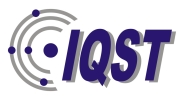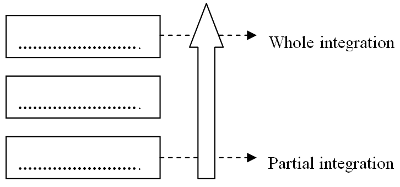Contextual Teaching and Learning of Integrated Science in Lower and Upper Secondary Schools
The Specificities of Integrated Science Teaching in Lower and Upper Secondary School
- To perceive the specificity and significance of science education at lower and higher stages of secondary school.
- To find out why a positive emotional students’ disposition in terms of science education is so important for the above mentioned stages of secondary school.
- To analyze teacher’s role in the process of teaching an integrated course on sciences in the forms of lower and upper secondary school.
- To specify the integration levels of different branches of sciences.
- the fifth-formers start learning individual subjects; they are taught by several teachers, new educational subjects appear, the problems of adaptation, etc. occur. One of the key issues is the sponsion of integrated natural science education in forms 5 and 6;
- natural science background acquired in primary school is further developed in forms 5 and 6, active learning of individual science subjects in higher forms approaches; the situation partially determines a choice of sciences in forms 11 and 12. Motivation is highly important in this case. Interest in natural sciences is rather low in most of the countries (Lukason, 1997);
- a sensual – affective component is still prevailing. Effective natural sciences teaching based on children’s intellect is not the only and the foremost task. Their mind and senses should be involved. In order to reach the goal, the expedient usage of art classes should be helpful.
A.Blum (1994) notices that integrated science curricula differ in the degree to which they are integrated, with distinctions being made between coordination, combination, and amalgamation (full integration) (p.2901).
- quantitative changes of an ordinary curriculum, making it “easier” or “heavier” cannot be the means of restriction;
- the needs and opportunities of exclusive schoolchildren must be evaluated;
- should be designed in order to meet an exclusive pupils’ style of learning and recommended methods of teaching;
- should reflect the specificities that make these pupils different among their contemporaries.
P.Shlesinger also pays attention to the teacher. He says that the role of the teacher becomes even more significant in the process of integrated teaching as teachers have to cooperate, take decisions, look for effective methods to retain teaching material for a longer period of time (Shlesinger, 1996). The importance of the teacher to successful systemic (integral) teaching is stressed by a number of authors (Fink, 1985; Risholm, 1997; Johannessen, 1997; Mikalsen, 1997; Gedrovics, 1997, etc.). P.Jarvis supposes that the integration of educational subjects should guarantee reflective (involved) teaching/learning through practic experience. Therefore, the author treats learning in a different way. P.Jarvis understands learning as changes of behaviour, as the result of experience and practice (Jarvis, 1993). Z.Alaunienė is certain that, “no matter how good the educational curricula or textbooks should be designed the final integration depends on the teacher. Only s/he observes how a student perceives and acquires knowledge, only s/he coordinates training, gives assignments to develop the learner’s abilities and skills” (Alaunienė, 1991). Along integrated education the teacher has enormous influence on schoolchildren. With awareness and analysis of the format of this influence the teacher can be the best to notice what should be changed or improved in the process of integrated education. In this case, regular contemplation of personal activities and competence, self-assessment, understanding of the permanent alteration of educational paradigms is necessary.
Most educators would agree that the basic tenets of constructivism describe the way we have "always known that people learn." Still some teachers resist constructivist pedagogy.
Teacher education programs must begin to foster in beginning teachers of all disciplines new images of collaboration, involvement, and inquiry-images of classroom environments where students of all cultures engage in interdisciplinary activities and construct knowledge rooted in their own personal experiences.
- explicitly talk about preliminary everyday knowledge to make it conscious;
- show the inconsistencies between everyday and scientific explanations and their reasons;
- verbally teach the new explanations and give time to think and discuss about them;
- use models and analogies to enhance the understanding.
We consider that integrated teaching, if involved into the sociocultural context, will help the student to comprehend the causal relations. It will develop the personality and form moral orientations and standpoints together with habits to independently apply the acquired knowledge in real life situations. Such teaching and learning are characterized by integrity. Integrated teaching diminishes inconsistencies between the knowledge that separate subjects impart as well as the necessity and inevitability of the synthesis. The only fact of presenting the content is not the essence of teaching. The main point is work, a widely sided and motivated activity. In order to direct the teaching process in the desirable direction, it is imperative to encourage the motivation for learning. In this respect the principle moment cannot be neglected. A student cannot only master but also apply the basic knowledge in practice. Therefore, the duty of every teacher is to reveal and show to the students their potential powers (Lamanauskas, 2003).
Tasks (assignments)- What are the specificities of science education at the stages of primary and secondary education? How is the significance of science education expressed at the above mentioned stages?
- With reference to the principles of constructivistic teaching / learning, knowledge of psychology at different age stages and / or practical experience, reason the idea presented in learning material that a sensual – affective component is still prevailing. Effective natural sciences teaching based on children’s intellect is not the only and the foremost task.
- Define teacher’s role teaching an integrated course on sciences in the forms of lower and upper secondary school.
- Describe different integration stages of sciences: coordination, combination and amalgamation (A. Blum, 1994). Put the above introduced levels of integration considering a degree of integration starting from the lowest one:
for full size click on image
As it was mentioned in the above presented theoretical material of the module, profiled teaching in Lithuania was introduced in 2001. On the basis of the previously mentioned provisions for learning, the integrated course on sciences is devoted to the upper secondary school students of forms 11 and 12 preferring a humanitarian profile of learning and interested in choosing the follow-up studies or types of professional activities other than sciences. This course concentrates on modern achievements in sciences, life experience and environmental problems. All topics are examined in broad outline, the evolution of sciences is described as a method of acknowledging nature, the issues of personal and public life are emphasized, natural phenomena, scientific ideas and experiments are given more thorough analysis. The integrated course on sciences is devoted to help a learner with pursuing general science education and developing the ability to distinguish between scientific and non-scientific issues as only a sufficiently sophisticated person can be actively involved in solving the problems of a modern country. The course assists the learners in perceiving the significance of sustainable development ideas and protecting biosphere and the quality of public life.
Questions to Case Study- What is the degree of the integration (A. Blum, 1994) of sciences discussed in the above presented example? Reason your position.
- What extent of science content should be presented to the students of the humanitarian profile?
Contextual Teaching and Learning (CTL) integrates inquiry, problem- and project-based learning, cooperative learning. Contextual teaching and learning undoubtedly is consistent with a constructivist approach for the teaching of science in secondary schools. Contextual science teaching usually include inquiry learning, problem-based learning, cooperative learning, project-based learning, and authentic assessment. It is obvious, that learners and contexts differ, there can be no single best approach for the teaching of science. Effective teaching and learning in science requires a variety of approaches.
Frequently Asked Questions- science learning is difficult. Usually the majority of students have difficulty understanding science concepts; also students have limited experiences;
- science learning is characterised by misconceptions, which have been noted in practically all subject areas of science;
- science learning is inert. Inert knowledge is considered to be knowledge accessible only in a restricted set of situations.
Barman, C. (1997). The learning cycle revisited: A modification of an effective teaching model. [Monograph #6]. Washington, DC: Council for Elementary Science International.
Brooks, J. G. & Brooks, M. G. (1993). The case for constructivist classrooms. Alexandria, VA: Association for Supervision and Curriculum Development.
Hacker, R. G. (1984). A typology of approaches to science teaching in schools. International Journal of Science Education, Vol. 6, Issue 2, p. 153-167.
Kahle, Jane Butler, Riley, D. (1993). Gender differences in science education: building a model. Educational Psychologist, Vol. 28, Issue 4, p. 379-405.
Lamanauskas V. (2003). Natural Science Education in Comprehensive School. Siauliai: Siauliai University Press, p. 514.
Richardson, V. (1997). Constructivist teaching and teacher education: Theory and practice. In V. Richardson (Ed.), Constructivist teacher education: Building a world of new understandings (pp. 3-14). Bristol, PA: Falmer.
ReferencesAlaunienė Z. (1991). Mokymo turinio integracijos problemos. Tautinė mokykla, Nr.7, P.16-18.
Blum A. (1994). Integrated and General Science. In.: T.Husen, T.N.Postlethwaite (eds.) The International Encyclopedia of Education, Vol.5, P. 2897-2903.
Boyer E.L. (1983). High School: a Report on Secondary Education in America. New-York.
Brown J.S., Collins A., Duguid P. (1989). Situated Cognition and the Culture of Learning. Educational Researcher, Vol.18 (1), P. 32-41.
Chi, M. (1992). Conceptual change within and across ontological categories: Examples from learning and discovery in science. In: R. Giere (Ed.) Cognitive models of science. Minnesota Studies in Philosophy of Science, 15 (pp. 129-187). Minneapolis: University of Minnesota Press.
Dabrišienė V. (1997). Integruoto ugdymo programų principai ir jų sudarymo modelis. Kn.: Edukologija. Kalbotyra. Literatūrologija (I respublikinės doktorantų ir jų mokslinių vadovų konferencijos medžiaga). Vilnius, p. 145-149.
Diakidoy, I.-A., & Kendeou, P. (2001). Facilitating conceptual change in astronomy: A comparison of the effectiveness of two instructional approaches. Learning and Instruction, 11, 1-20.
Goodlad J.I. (1983). A Place Called School: Prospects for the Future. New York.
Jarvis P. (1993). The Learning Process and Late Modernity. Scandinavian Journal of Educational Research, Vol.37 (3), P. 179-190.
Johannessen T.A., Gronkauy K., Risholm N.S., Mikalsen Q. (1997). What is Important to Students? Exploring Dimensions in Their Evaluations of Teachers. Scandinavian Journal of Educational Research,Vol. 41(2), P. 165-177.
Kaufman, D. Brooks J. (1996). Interdisciplinary Collaboration in Teacher Education: A Constructivist Approach. TESOL Quarterly, Vol. 30, No. 2, pp. 231-251.
Lamanauskas V. (2003). Natural Science Education in Lithuanian Secondary School: Some Relevant Issues. Journal of Baltic Science Education, No.1, p. 44-55.
Lukason A. (1997). Natural Science – popular or distained subjects? In.: Science and Technology Education for Social and Economic Development (Second IOSTE Symposium for Central and East European Countries). Liublin, p.21.
Sandoval J. (1995). Teaching in subject Matter Areas. Annual Review of Psychology, Vol.46, P. 355-375.
Schlesinger Phyllis F. (1996). Teaching and Evaluation in an Integrated Curriculum. Journal of Management Education, Vol. 20(4), P.479-486.
Smith, C., Maclin, D., Grossligth, L., & Davis, H. (1997). Teaching for understanding: A study of students’ preinstruction. Theories of matter and a comparison of the effectiveness of two approaches to teaching about matter and density. Cognition and Instruction, 15, 317-393.
Tõldsepp A., Toots V. (2003). Research and development work from the perspective of compiling balanced curricula for science education. Journal of Baltic Science Education, No.1, p. 5-11.
Tsang Eric W.K. (1997). Organizational Learning and the Learning Organization: A Dichotomy Between Descriptive Research. Human Relations, Vol.50 (1), P. 84-85.
Vaitkevičius J. (1995). Socialinės pedagogikos pagrindai. Vilnius: Egalda.
Гедровиц Я. (1997). Опыт составления интегрированной программы курса "Естествознание" для гуманитарной средней школы. В кн.: Профессиональная культура педагога как определяющий фактор обновления школы. Витебск, с. 61.
Киричёк П. (1997). Интегральная форма образования. Высшее образование в России, №1, С. 154.
Макаркин Н., Наумченко И. (1996). Интеграция региональных систем образования: из опыта работы регионального учебного округа Мордовского университета. Саранск.





